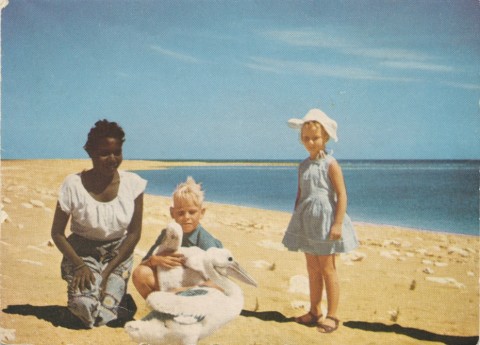The Mornington Shire administers the Wellesley group of islands in the south-east of the Gulf of Carpentaria, 220 km north-west of Normanton. The largest island in the group is Mornington Island and the next largest is Bentinck. All the names were given by Commander Matthew Flinders, RN, probably when imprisoned by the French in Mauritius: Richard Wellesley, 2nd Earl of Mornington and Governor-General of Bengal, and Lord William Bentinck, Governor of Madras, interceded on Flinders' behalf in an attempt to have him released.
The principal language groups in the Wellesley Islands are the Lardil (Mornington Island), the Yungkal (islands west of Mornington) and the Kaiadilt (Bentinck Island). They were virtually untouched by European contact until 1909 when the Chief Protector of Aborigines reported that although the Mornington Island people appeared 'emaciated' they were free from disease, strong and agile. In 1914 the Presbyterian Church established a mission, taking in many of the Lardil people. Some traditional practices, especially male circumcision, were forbidden, with unanticipated injury to male status. Children were kept in separate dormitories for girls and boys; families tended to desert their traditional island localities and live around the mission.
In 1948 the Kaiadilt people were brought from Bentinck Island when sea water polluted their fresh supply. Presbyterian/Uniting church management continued until the 1970s. Opinion on their influence is varied. An ethnographer who lived on the island for five years concluded that missionaries were stern but fair, and arrived poor and left poor. Reverend Douglas Belcher was in charge from 1952-72 and is credited with encouraging some traditional cultural practices. The Mornington Island State primary school opened in 1975.
In 1978 the Queensland Government created a shire for local government. There were more Europeans than before, most of them less effective or helpful than the missionaries. Alcohol became freely available. Death rates from alcoholism, suicide and homicide greatly increased over the ensuing decades. At the same time other trends emerged. Dick Roughsey (c1920-1985), a Mornington Islander, wrote and illustrated several popular storey books. Dance displays and body art were revived. The Paddy Reid Memorial Arts and Crafts Centre was opened in the 1990s. In 2005 the Kaiadilt women's art movement began, unexpectedly from a group who had experienced under-dog status for decades.
Mornington shire's administrative centre is Gununa. In 2008 native title was recognised for all of the Wellesley Islands except Gununa, where there are a hospital, a P-10 state school and a post office. The tavern was scheduled for closure following a community decision in 2008 to reduce alcoholism.
Mornington shire's census populations have been:
| Census Date | Population |
|---|---|
| 1981 | 773 |
| 1996 | 1114 |
| 2006 | 1032 |
| 2011 | 1142 |
At the 2011 census the median age of residents was 26 years, compared with 37 for Australia. Aboriginal and Torres Strait Islanders made up 88% of the population.
Gununa's census populations have been:
| census date | population |
|---|---|
| 2006 | 990 |
| 2011 | 1126 |
Amanda Ahern, Paint-up, St Lucia, University of Queensland Press, 2002
Virginia Huffer, The sweetness of the fig: Aboriginal women in transition, Sydney, UNSW Press, 1980
David McKnight, From hunting to drinking: the devastating effects of alcohol on an Australian Aboriginal community, New York, Routledge, 2002
The heart of everything: the art and artists of Mornington and Bentinck Islands, Fitzroy, Vic, McCulloch and McCulloch, 2008

